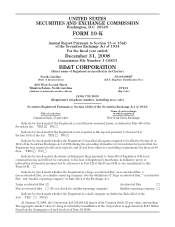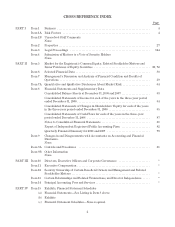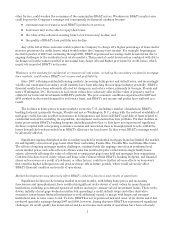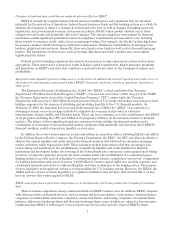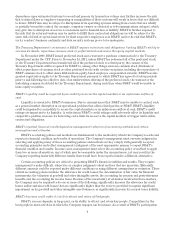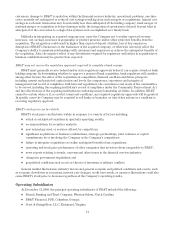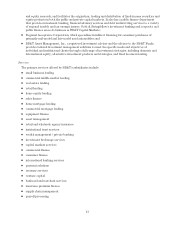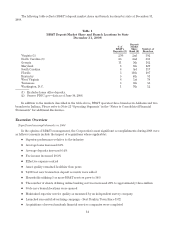BB&T 2008 Annual Report Download - page 6
Download and view the complete annual report
Please find page 6 of the 2008 BB&T annual report below. You can navigate through the pages in the report by either clicking on the pages listed below, or by using the keyword search tool below to find specific information within the annual report.impacted. Reflecting concern about the stability of the financial markets generally and the strength of
counterparties, many lenders and institutional investors have reduced, and in some cases, ceased to provide
funding to borrowers including other financial institutions. Although to date BB&T has performed relatively well
during the current financial crisis as compared with the Company’s peers and several of the largest financial
institutions, BB&T is part of the financial system and a systemic lack of available credit, a lack of confidence in
the financial sector, increased volatility in the financial markets and reduced business activity could materially
and adversely affect BB&T’s business, financial condition and results of operations.
The capital and credit markets have experienced unprecedented levels of volatility.
During 2008, the capital and credit markets experienced extended volatility and disruption. In the third
quarter of 2008, the volatility and disruption reached unprecedented levels. In some cases, the markets produced
downward pressure on stock prices and credit capacity for certain issuers without regard to those issuers’
underlying financial strength. If these levels of market disruption and volatility continue, worsen or abate and
then arise at a later date, BB&T’s ability to access capital could be materially impaired. BB&T’s inability to
access the capital markets could constrain the Company’s ability to make new loans, to meet the Company’s
existing lending commitments and, ultimately, jeopardize the Company’s overall liquidity and capitalization.
In response to financial conditions affecting the banking system and financial markets and the potential
threats to the solvency of investment banks and other financial institutions, the U.S. government has taken
unprecedented actions. These actions include the government assisted acquisition of Bear Stearns by JPMorgan
Chase, the federal conservatorship of Fannie Mae and Freddie Mac, and the plan of the United States
Department of the Treasury (the “Treasury Department”) to inject capital and to purchase mortgage loans and
mortgage-backed and other securities from financial institutions for the purpose of stabilizing the financial
markets or particular financial institutions. Investors should not assume that these governmental actions will
necessarily benefit the financial markets in general, or BB&T in particular. BB&T could also be adversely
impacted if one or more of its direct competitors are beneficiaries of selective governmental interventions (such
as FDIC assisted transactions) and BB&T does not receive comparable assistance. Further, investors should not
assume that the government will continue to intervene in the financial markets at all. Investors should be aware
that governmental intervention (or the lack thereof) could materially and adversely affect BB&T’s business,
financial condition and results of operations.
The soundness of other financial institutions could adversely affect BB&T.
Financial services institutions are interrelated as a result of trading, clearing, counterparty, or other
relationships. BB&T has exposure to many different industries and counterparties, and BB&T and certain of its
subsidiaries routinely execute transactions with counterparties in the financial services industry, including
brokers and dealers, commercial banks, investment banks, mutual and hedge funds, and other institutional
clients. Many of these transactions expose the Company to credit risk in the event of default of its counterparty
or client. In addition, the Company’s credit risk may be exacerbated when the collateral held by it cannot be
realized upon or is liquidated at prices not sufficient to recover the full amount of the loan or derivative exposure
due BB&T. These types of losses could materially and adversely affect BB&T’s results of operations or earnings.
Changes in interest rates may have an adverse effect on BB&T’s profitability.
BB&T’s earnings and financial condition are dependent to a large degree upon net interest income, which is
the difference between interest earned from loans and investments and interest paid on deposits and borrowings.
The narrowing of interest rate spreads, meaning the difference between interest rates earned on loans and
investments and the interest rates paid on deposits and borrowings, could adversely affect BB&T’s earnings and
financial condition. The Company cannot predict with certainty or control changes in interest rates. Regional and
local economic conditions and the policies of regulatory authorities, including monetary policies of the Federal
Reserve Board, affect interest income and interest expense. The Company has ongoing policies and procedures
designed to manage the risks associated with changes in market interest rates. However, changes in interest
rates still may have an adverse effect on BB&T’s profitability. For example, high interest rates could adversely
affect the Company’s mortgage banking business because higher interest rates could cause customers to apply for
fewer mortgage refinancings or purchase mortgages.
6

